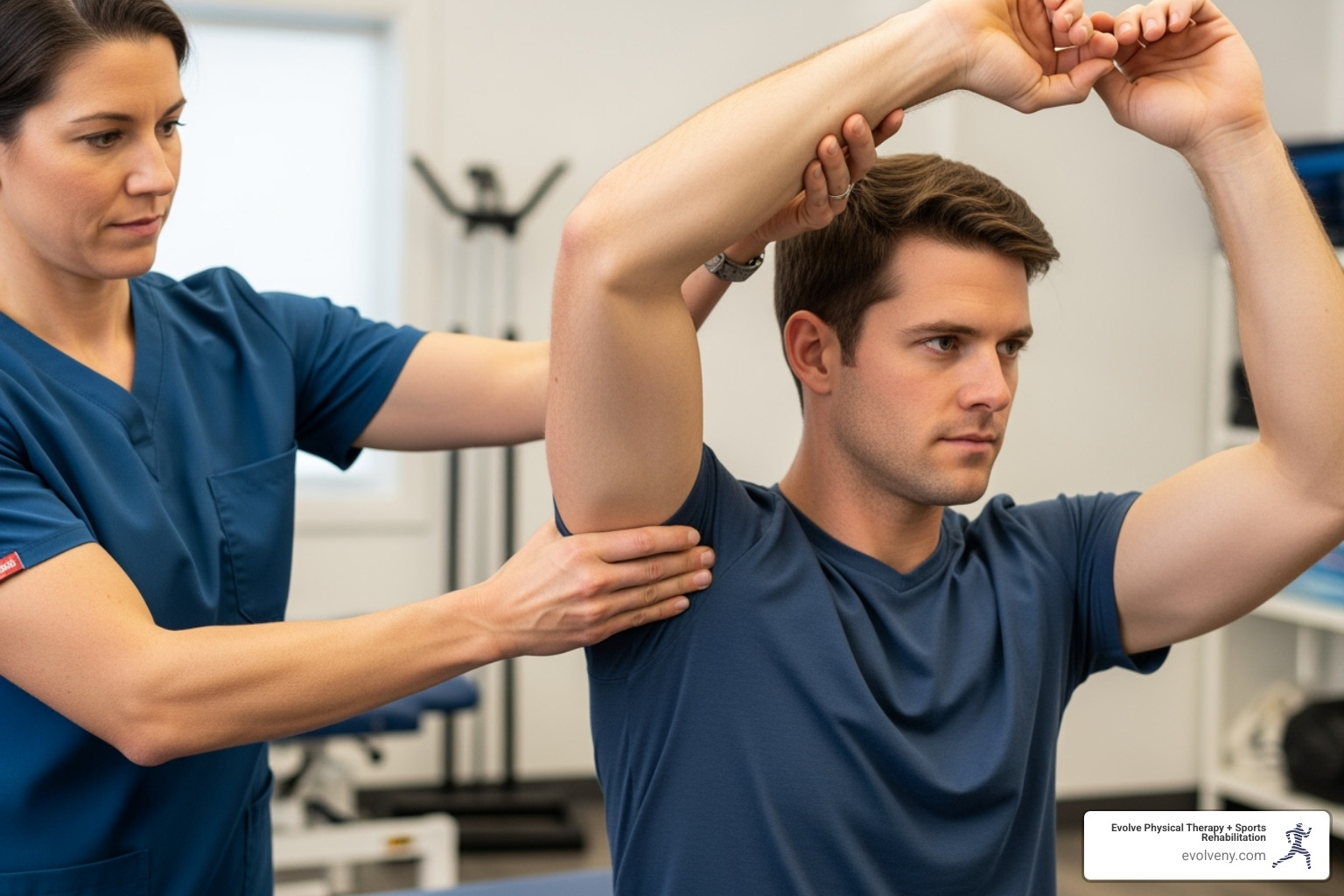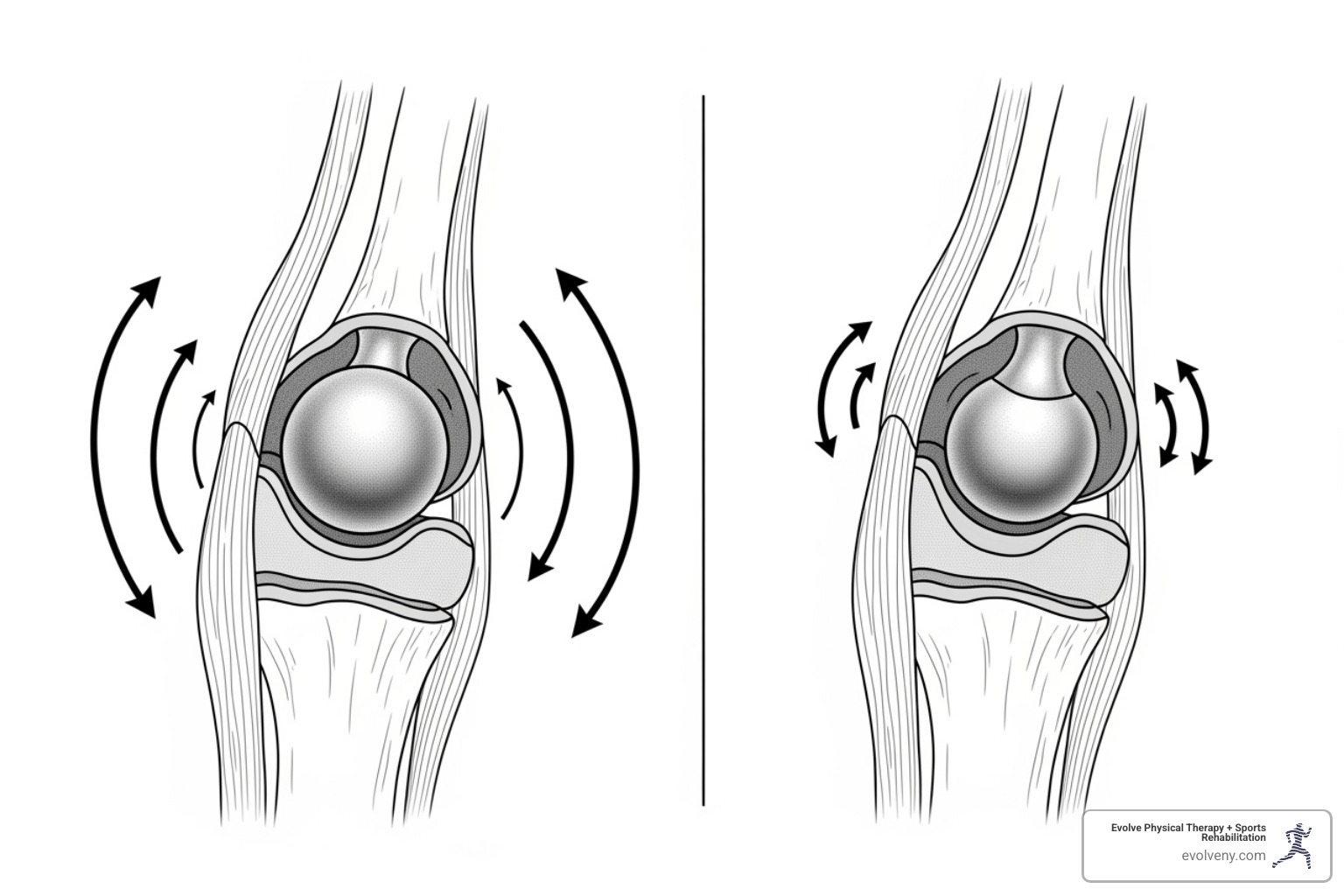Mobilization Magic: Improving Shoulder Flexion Explained
Understanding Mobilization with Movement for Shoulder Flexion

Wondering how does mobilization with movement improve shoulder flexion? This hands-on physical therapy technique addresses key factors limiting your shoulder's range of motion by:
- Correcting Joint Alignment: MWM realigns minor "positional faults" in the shoulder, allowing bones to glide smoothly.
- Reducing Pain Signals: It calms the nervous system, breaking the cycle of pain and stiffness.
- Restoring Natural Movement: By combining a manual glide with your active movement, MWM retrains your brain and muscles for a natural, pain-free range of motion.
Shoulder flexion—raising your arm forward and up—is vital for daily tasks. When it's painful or limited, it can severely impact your life. Mobilization with Movement (MWM) is a game-changer for stiff or painful shoulders, quickly improving motion and reducing pain. Experts like Louis Ezrick specialize in this technique, helping countless patients regain full, pain-free movement.

What is Mobilization with Movement (MWM) for the Shoulder?
Mobilization with Movement (MWM) is a manual therapy technique developed by New Zealand physical therapist Brian Mulligan. Its goal is to restore free, painless joint movement. With MWM, a physical therapist applies a sustained, guiding glide to your joint while you actively perform the problematic movement. This combination corrects subtle "positional faults," allowing the joint surfaces to glide smoothly.
For the shoulder, MWM focuses on the ball-and-socket (glenohumeral) joint, where the humeral head moves inside the glenoid fossa of the scapula. We use precise, gentle pressure to improve how the humeral head glides in the socket 6especially important for smooth shoulder flexion (raising your arm forward and up).

Choosing the Correct Glide Direction
To help with shoulder flexion, therapists most commonly use an inferior or posteroinferior glide, because the humeral head must glide slightly downward (and often a bit posterior) as the arm lifts. In certain presentations such as when internal rotation is also limited a predominantly posterior glide can be effective. Your therapist will assess which direction immediately reduces pain and restores range.
You can see an example of one of these approaches here: Posterior Glide to increase flexion.
The Core Principles of MWM
- Sustained accessory mobilization a steady, gentle force is applied throughout the movement.
- Active physiological movement you actively move your shoulder while the therapist maintains the glide.
- Pain-free application any pain means we modify direction, force, or technique.
- Repetition for lasting effect several pain-free repetitions "re-set" the nervous system.
- Self-treatment options once the correct glide is identified, we can teach you how to reproduce it at home with a belt or strap.
Applying MWM to Improve Shoulder Flexion
- Identify the painful movement for example, difficulty lifting your arm overhead.
- Determine the optimal glide usually inferior or posteroinferior, occasionally posterior.
- Therapist hand placement precise contact over the humeral head to apply the glide.
- Patients active flexion you raise your arm while the therapist maintains the glide.
- Constant communication your feedback ensures the movement stays 100 % pain-free.
Each repetition reinforces proper arthrokinematics, decreases pain, and teaches your brain that the movement is safe.
How Does Mobilization with Movement Improve Shoulder Flexion? The Science Explained
The effectiveness of MWM and how mobilization with movement improves shoulder flexion lies in its dual approach to biomechanical and neurophysiological restrictions.
Biomechanically, shoulder flexion requires the humeral head to spin with a slight inferior sometimes posteroinferior glide in the glenoid fossa. Capsular tightness or a minor positional fault can block this glide, causing pain or early impingement. By providing the missing accessory glide, MWM corrects the fault and instantly restores smoother motion.
Neurophysiologically, MWMs pain-free application calms the nervous system, reducing muscle guarding and pain sensitivity. This "resets" the painful movement, allowing the brain to perceive it as safe and immediately improving range.

Correcting Positional Faults
The positional fault theory suggests that minor joint misalignments limit motion and provoke pain. By applying a sustained inferior or posteroinferior glide during active flexion, MWM realigns the humeral head so it stays centered in the glenoid, immediately reducing pain and increasing elevation.
Key Mechanisms Behind the Improvement
- Pain Gate Theory non-painful joint input dampens pain signals at the spinal cord.
- Descending Pain Inhibition sensory input triggers the brains own pain-relief pathways.
- Sympathetic Modulation gentle, pain-free touch calms the fight-or-flight response that stiffens muscles.
- Reduced Fear-Avoidance seeing your arm move farther without pain breaks the cycle of guarding.
- Improved Motor Control better joint mechanics improve proprioceptive feedback, refining muscle coordination.
The Evidence: MWM's Effectiveness for Shoulder Conditions
The benefits of MWM for improving shoulder flexion are backed by solid scientific research. Systematic reviews and meta-analyses support its effectiveness for conditions like frozen shoulder, shoulder impingement, and rotator cuff pain, showing significant improvements in pain, range of motion (ROM), and function.
At Evolve Physical Therapy + Sports Rehabilitation, we're committed to using techniques with proven results. You can explore the research in this comprehensive systematic review: Efficacy of MWM for shoulder conditions: a systematic review.
What does research say about how mobilization with movement improve shoulder flexion?
Research shows impressive results for how does mobilization with movement improve shoulder flexion:
- For patients with a frozen shoulder, MWM improved flexion by an average of nearly 12 degrees.
- For those with general shoulder pain and movement dysfunction, it led to an average improvement of over 18 degrees.
These gains are clinically relevant, meaning they are large enough to make a noticeable difference in daily life. A key finding is that MWM often provides immediate effects within a single session, improving pain and range of motion right away.
Who Benefits Most from MWM?
MWM is a fantastic tool for a wide range of shoulder issues, but it is particularly effective for:
- Individuals whose movement is limited by reproducible pain, especially a painful arc.
- Those with subacute shoulder conditions that haven't yet become chronic.
- Older adults with shoulder dysfunction, as MWM is a safe and feasible treatment.
- Patients who have plateaued with therapeutic exercise alone, as MWM can address underlying joint mechanics that exercise may not correct.
MWM vs. Other Therapies: A Comparative Look
In physical therapy, we use many tools to improve shoulder flexion. Understanding how Mobilization with Movement (MWM) compares to other techniques highlights its unique advantages. It's about choosing the right approach for your specific needs.
| Feature | Mobilization with Movement (MWM) | Maitland Mobilization (Passive) | Therapeutic Exercise |
|---|---|---|---|
| Technique | Sustained manual glide + Active patient movement | Passive, oscillatory movements (various grades) | Active patient movement (stretching, strengthening) |
| Patient Involvement | High (active movement during mobilization) | Low (patient is passive) | High (patient performs all movements) |
| Primary Mechanism | Neurophysiological (pain modulation, motor control) + Biomechanical (positional fault correction) | Neurophysiological (pain modulation) + Biomechanical (capsular stretching, joint nutrition) | Biomechanical (muscle strengthening, flexibility, endurance) |
| Pain Response | Must be pain-free | Can be performed into mild pain (depending on grade/goal) | Should ideally be pain-free, but may involve discomfort |
| Immediate Effect | Often immediate pain reduction & ROM increase | Can have immediate pain reduction & ROM increase | Gains typically more gradual over time |
MWM combines the targeted joint correction of manual therapy with your active participation. This active role is key to retraining the nervous system and making the improved movement a natural part of your daily life.

MWM vs. Passive Mobilization (Maitland/Kaltenborn)
Passive mobilizations (e.g., Maitland) involve the therapist moving your joint for you while you relax. The key difference is patient involvement. With MWM, your active movement is crucial. While passive techniques can sometimes be performed into mild discomfort, MWM must be pain-free, which immediately signals to your brain that the movement is safe. MWM also specifically targets a "positional fault," while passive mobilizations often focus more on stretching tight tissues.
MWM vs. Therapeutic Exercise
Therapeutic exercise is essential for building strength and flexibility. However, a mechanical issue or pain can prevent you from performing exercises effectively. This is how does mobilization with movement improve shoulder flexion in a powerful way: it acts as a catalyst. MWM can instantly improve your range of motion and reduce pain, allowing you to perform your exercises more effectively and with better form. Think of MWM as restoring the joint's foundation so that strengthening exercises can be built upon it safely. MWM and exercise are partners; we use MWM to open up movement and exercise to make those gains permanent.
Is MWM for the Shoulder Always Safe? Risks and Considerations
Regarding how does mobilization with movement improve shoulder flexion, safety is our top priority. MWM is a gentle manual therapy technique, but it must be performed by a qualified physical therapist. A key safety feature is built into its core principle: MWM must be pain-free.
Pain is an alarm system; if a technique causes pain, it's either being performed incorrectly or is not the right approach for your condition. We immediately stop and adjust. This constant communication makes the technique both effective and safe. We are not forcing the shoulder to move but gently guiding it back to its natural, pain-free pattern.
Our thorough evaluation process at Evolve Physical Therapy + Sports Rehabilitation identifies any risks before treatment begins. We take time to understand your medical history and perform comprehensive tests to ensure MWM is appropriate for you. You can learn more about our commitment to safe, hands-on care here: More info about our hands-on physical therapy approach.
Potential Contraindications
While MWM is very safe, we exercise caution or avoid it in specific situations, including:
- Fracture: Recent or suspected breaks in the area.
- Joint Instability: A history of dislocation or the shoulder feeling like it's "slipping out."
- Malignancy: Known or suspected tumors in the treatment area.
- Inflammatory Arthritis: During active flare-ups (e.g., Rheumatoid Arthritis).
- Severe Osteoporosis: When bones are significantly weakened.
- Hypermobility: If joints are already overly flexible.
Our experienced therapists are trained to identify these conditions during your initial evaluation to ensure we choose the safest, most effective treatment for you.
Frequently Asked Questions about MWM for Shoulder Flexion
We often get asked questions about how does mobilization with movement improve shoulder flexion. Let's address some of the most common ones:
How many sessions of MWM are needed to see results?
A key benefit of MWM is that immediate improvements are common within the first session. Many patients leave their first appointment with noticeably less pain and more movement. The total number of sessions depends on factors like the severity and chronicity of your condition, your body's response, and your commitment to home exercises. A typical treatment course at Evolve Physical Therapy + Sports Rehabilitation involves several sessions over a few weeks, combining MWM with other therapies to achieve lasting results.
Can I perform Mobilization with Movement on myself?
Yes, after being properly taught by one of our qualified physical therapists, some MWM techniques can be adapted for self-treatment at home using a mobilization belt or strap. It is crucial that a therapist teaches you the correct technique, direction, and pressure to ensure safety and effectiveness. Self-MWM is a powerful tool that empowers you to continue your progress between sessions.
Does MWM hurt?
No, absolutely not. A core principle of MWM is that it must be and remain pain-free. If you feel any pain, it's a signal to us to immediately adjust the technique, glide direction, or pressure until the movement is comfortable. We reject the "no pain, no gain" myth. The goal of MWM is to gently guide your nervous system to allow pain-free movement, which reduces muscle guarding and fear, leading to immediate improvements in your shoulder flexion.
Conclusion
So, how does mobilization with movement improve shoulder flexion? It's a game-changing physical therapy technique that combines precise manual guidance with your own active movement. This unique partnership addresses the root causes of shoulder stiffness by correcting subtle "positional faults" and calming the nervous system to reduce pain signals and muscle guarding. The result is often immediate, pain-free improvement in your range of motion.
The pain-free nature of MWM is one of its most powerful aspects, and research confirms its effectiveness for conditions from frozen shoulder to general movement dysfunction. Because you are an active participant, MWM bridges the gap between passive treatments and exercise, helping you reclaim movements you thought were lost.
At Evolve Physical Therapy + Sports Rehabilitation, we've seen countless patients experience the benefits of our hands-on approach. Our team serves the Brooklyn communities of Marine Park, Gravesend, Midwood, Park Slope, and Mill Basin, and we are passionate about helping you get back to living without limits.
Your shoulder is designed to move freely. Let us provide the expert guidance to help it remember how. Ready to experience the difference?

